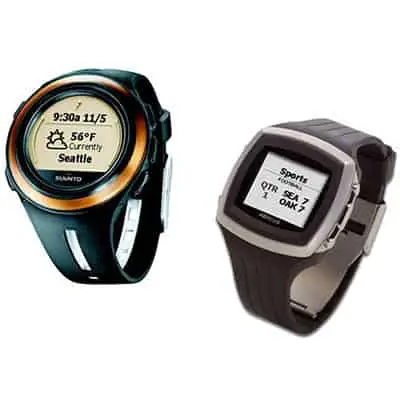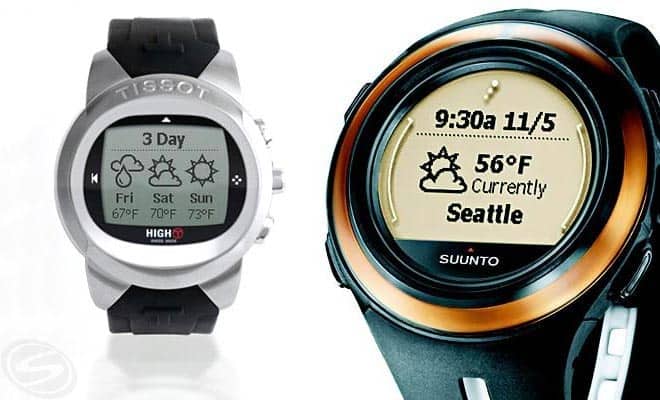The Microsoft SPOT Watch smartwatch was revolutionary, smart, and sexy — at least for technophile geeks. It was also a major commercial failure. The first SPOT Watch models were released to great fanfare in 2004, but new product development ceased only two years later. The Microsoft SPOT Watch line was officially killed in 2008, with only a few diehard enthusiasts mourning its passing. By the time Bill Gates quietly shuttered the network service behind SPOT technology in 2011, no one seemed to notice.
SPOT stands for Smart Personal Object Technology, an initiative by Microsoft to personalize household electronics and other everyday gadgets. The SPOT Watch was its flagship product, but the technology was also made available on other products like car navigation systems and coffeemakers. SPOT was backed by the MSN Direct Network, which enabled users to receive instant messages from Windows Messenger as well as receive personalized news headlines, stock updates, and weather forecasts.
SPOT Watches captured imaginations when they were first announced, conjuring images of Dick Tracy’s wrist radio or the communicator wristwatch from Knight Rider. For the fashion-conscious technophile on the go, it seemed like the ideal way to get information delivered without having to pack a bulky laptop or even pull out a smartphone. Though there was a skeptical minority, most of geekdom waited with anticipation for the SPOT Watch’s release. However, it soon became obvious that the SPOT Watch was a product in search of a niche.
Launched at a time when the first generation of smartphones were just starting to gain traction amongst the general population, the watch was supposed to offer information at a glance where other devices would have required more immersion and interaction. The SPOT Watch had a monochrome 90×126 pixel screen, roughly comparable to the resolution of the first generation Game Boy. This was combined with the small screen size which meant the watch could display only a very limited amount of information on its screen.
Price was also an issue. At launch, SPOT Watch models ranged up to $300, a steep price to pay for something that wasn’t able to do anything contemporary smartphones couldn’t do. It was also quite bulky, eliciting complaints about its size and poor fit compared to conventional watches. The relatively short battery life also proved problematic. It was advertised as being able to operate for three days on a full charge, but that was highly dependent on the amount and type of usage the watch was put through. Some users found that duration simply inadequate, and the necessity of having to regularly charge the watch too inconvenient.
Finally, there was the data network that SPOT smart watches operated on. Instead of opting for standardized wireless communications protocols, Microsoft decided to build a proprietary network using FM radio signal. While this gave Microsoft total control over the devices, it also meant that they were incompatible with a user’s other devices as well as locked out of any services that competing networks had to offer. Furthermore, using FM signal meant that there were gaps in coverage, as Microsoft had to negotiate over bandwidth with different providers in various markets. In more rural areas or in places where Microsoft was unable to secure bandwidth, the SPOT Watch was simply a very bulky and expensive watch that had limited functionality.

When the Microsoft SPOT Watch was launched, its functionality was roughly competitive with, albeit more streamlined than, the smartphones of the time. Smartphone technology progressed rapidly though, with newer models with better displays and more functionality quickly rendering the SPOT Watch quaint if not entirely obsolete. For those and other reasons, SPOT smart watches died a quiet and mostly unnoticed death a mere four years after their launch, as Microsoft finally gave up on the concept and pulled the plug. The MSN Direct network lingered a bit longer, delivering data to Garmin’s line of car GPS products. However, it too ceased service in 2011.
With today’s rapid pace of technological development, the Microsoft SPOT Watch might as well have belonged to a past geologic age. However, the desire for smart watches hasn’t faded away. Learning from Microsoft’s mistakes, a number of companies have recently undertaken development of smartwatch products with an eye towards overcoming Microsoft’s shortcomings.
Recent smartwatches offerings have taken advantage of modern display technology to offer full color screens at a higher resolution, while innovations in e-paper and flexible glass mean that smart watch designs can be as slim and comfortable as conventional watches. Battery life, considered by some to be one of the main failings of the Microsoft’s SPOT Watch, is being addressed by improvements in battery technology. The Sony SmartWatch, for example, can operate for up to 14 days with light usage.
The fundamental approach towards smartwatch design philosophy is also changing. Instead of Microsoft’s approach, with the SPOT Watch existing alongside but independent of and cut off from the user’s other devices, modern smartwatch developers are looking to integrate their products with other devices as part of a unified and smoothly interacting whole. Standardization around Wi-Fi and Bluetooth means that modern smart watches can be tethered to computers, smartphones, and other devices, allowing users to customize what kind of information gets passed on. Smart watches can become a convenient point of delivery for customized data, keeping users more connected and up to date without having to constantly reach for their smartphones. In today’s hectic and data-driven world, that is a considerable advantage.
One of the most promising and anticipated smartwatch designs is the upcoming Apple iWatch. Details were first leaked in February 2013, with one of the key components reported to be a flexible glass display. It is further reported that Apple has a large team working on the iWatch, and that development is well beyond the experimental phase. While other companies have smart watches in development or already released, Apple’s proven ability to introduce devices that have the capability to alter consumer lifestyle habits means that the iWatch is a product to watch out for.
The future of the smartwatch is still uncertain. It has yet to establish mass market appeal or prove itself as a useful addition to the modern technophile’s gadget arsenal. Where Microsoft was ultimately unsuccessful, Apple and other companies delivering a new generation of smart watches may yet change the way people work and live.
Want to walk down Memory Lane? Watch our video review of this classic Microsoft SPOT Watch by Tissot …
Source
Microsoft SPOT Watch: [Wikipedia]

